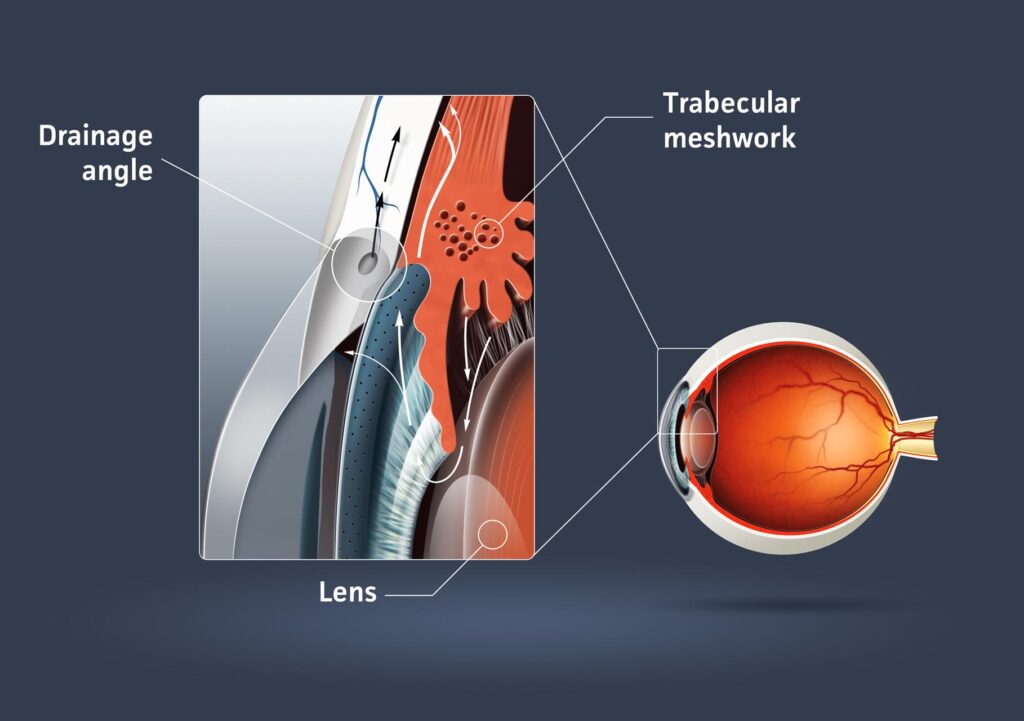What is glaucoma?
Glaucoma, also known as glaucoma, refers to abnormal changes in the eye that result in a loss of visual field. This is usually caused by increased pressure inside the eye, which means that the aqueous humor cannot drain properly. This increased pressure can damage nerve fibers in the retina, causing visual field disturbances and even blindness if left untreated. Unfortunately, there is no cure for glaucoma, but early treatment can help preserve vision and keep the condition under control.
How is eye pressure balance achieved?
To achieve intraocular pressure balance, a watery fluid called aqueous humor is continually secreted by a structure called the radiating body and flows into the anterior chamber of the eye. This aqueous humor serves to supply tissues with nutrients and maintain adequate pressure, which is important for the function of the eye. Normally, the aqueous humor flows through an opening between the lens and the iris and through the pupil into the anterior chamber of the eye and from there through a kind of filter layer, the trabecular meshwork, into the bloodstream. Any disruption to this process can lead to an increase in eye pressure, which particularly damages the blood vessels of the optic nerve and can lead to loss of visual field and even blindness.
Risk groups:
There are certain groups that are at higher risk of developing glaucoma. This includes:
-
Persons older than 40 years.
-
People who have a family history of glaucoma.
-
Overweight
-
Diabetics
-
People of color
However, it should be remembered that glaucoma can occur in any person and at any time.
Different forms of glaucoma
The term glaucoma summarizes various eye diseases that differ in their course or cause.
Chronic glaucoma is the most common form and is characterized by progressive obstruction of the trabecular meshwork in the eye, leading to an increase in intraocular pressure. This glaucoma develops slowly and without any obvious symptoms, which makes it dangerous as it can cause irreversible damage before the patient realizes it.
Acute glaucoma is characterized by a sudden increase in pressure in the eye caused by a blockage in the outflow of aqueous humor. It can cause severe headaches, nausea, eye redness, blurred vision, and rings of color around lights. If not treated quickly, it can cause irreparable damage.
Glaucoma with low eye pressure. In some cases, optic nerve damage can occur despite normal eye pressure. This type of glaucoma is called “normal-tension glaucoma” and is the subject of further investigation. Recent studies suggest that the condition may be related to a hardening of the arteries that carry blood to the optic nerve. The best way to address this problem is through the use of drugs to lower the pressure in the eye below normal or through surgery.
Congenital glaucoma occurs when babies are born with obstructions in the eye’s drainage ducts. Sight can be preserved by surgically removing a drain from the blocked area.
Secondary glaucoma develops due to various factors such as eye injuries, certain medications, diseases, inflammation and others. This leads to congestion and accumulation of aqueous humor in the eye, combined with an increase in pressure. The impairments can be temporary and completely reversible once the cause is identified and eliminated. Nevertheless, medical or surgical treatment is usually required.
Treatment options for glaucoma
Glaucoma, also known as glaucoma, can be treated both conservatively and surgically. Drug treatment is by administering drops aimed at reducing aqueous humor production or increasing outflow opportunities. An alternative to this is laser treatment, such as trabeculoplasty, in which an argon laser beam is aimed at the trabecular meshwork to increase filtration. However, this intervention only has a temporary effect. In acute glaucoma, laser surgery or microsurgery can be used to relieve fluid retention by making an opening in the iris.
A flap is surgically placed to reduce pressure in the eye when drug or laser treatments have not worked or the side effects are too great. The surgeon selects the method appropriate for the patient. A combination of drug treatment and surgical treatment may be necessary in some cases. If the procedure has little effect on the pressure in the eye, a second procedure at a different site may sometimes be necessary.
How to live with glaucoma?
Living with glaucoma can be well controlled by taking medication regularly and keeping appointments with your doctor. It is important to follow the doctor’s instructions carefully and to have regular check-ups. In addition, all other treating physicians should also be informed about the glaucoma and no other medication should be taken without prior agreement. Glaucoma is not contagious and with regular treatment it can preserve vision and allow a normal life.
